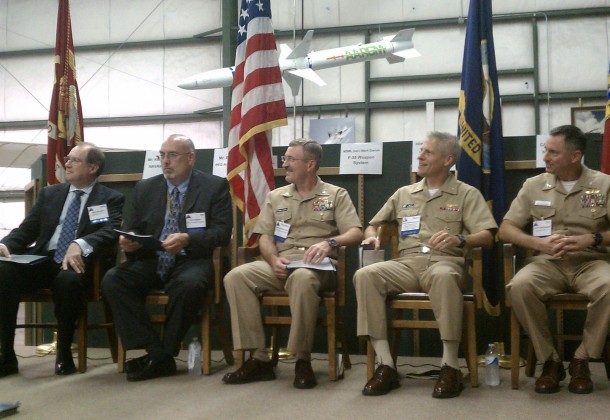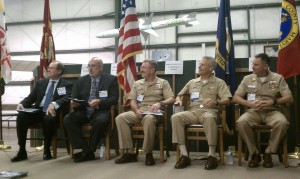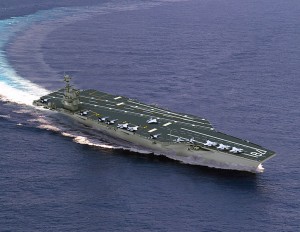Building the Supercarrier

The Patuxent Partnership
Leading Edge
When you are building a brand new 100,000-ton aircraft carrier that will serve as the template for American air power projection for the next several decades with several modern technologies, things can get a bit complicated.

The USS Ford Integration Panel included, from the left, Keith Sanders, Bill Deligne, Rear Adm. Mark Darrah, Rear Adm. Matthew Klunder and Capt. Brad Kidwell. Click for a larger image.
So, last Thursday, the Patuxent Partnership, working with the Association of Naval Aviation Patuxent River Squadron, brought together a panel of miltary, government and industry representatives responsible for ensuring that all the moving parts of the USS Gerald Ford (CVN-78) will work in unison when she takes to sea in 2015.
“It was a program that, from the beginning, was designed to look into the future,” said Keith Sanders, NAVAIR’s Assistant Commander for Acquisition (AIR-1.0), who moderated the panel at the Patuxent River Naval Air Museum in Lexington Park, Maryland. “It’s one of the few programs we’re doing right.”
Sanders said he is not criticizing other procurement programs. He meant that, from the beginning, the USS Ford was designed and planned as a “system of systems,” and integration has been made a high priority to avoid time-consuming redesigns.
“Nothing we’re going to cover tonight … will cover the blood, sweat and tears that each of you have put into this,” Sanders said to the panel.
Bill Deligne, executive director of the Aircraft Carriers Program Executive Office, NAVSEA, said that the USS Ford is the first new aircraft carrier design built since the Nimitz, 40 years ago. He said that half of the ship’s hull has been assembled with 24,000 tons of steel already sitting in the dry dock in Newport News, Va.
“We’re on track for launch in 2013 and delivery in 2015,” Deligne said.
Rear Adm. Mark Darrah, who was recently named “Tailhooker of the Year,” was brought in to discuss his role as co-lead of cost schedule performance management for the new aircraft component for the USS Ford, the F-35 Lightning II Joint Strike Fighter.
“We’re making some headway,” Darrah said of the JSF program, which has seen cost overruns and delays. “We’re finding successes, but we also have some big challenges.”
Darrah said the JSF is forcing planners to rethink carrier flight deck operations. The plane needs lithium-ion batteries that require shipboard storage and recharging. It needs a cooled jet blast deflector for its massive engine thrust. And it has a 270-volt power requirement for deck operations.
The job of coordinating the USS Ford’s information flow has fallen to Rear Adm. Matthew Klunder, special assistant to the Deputy Chief of Naval Operations for Information Dominance (N2/N6). Klunder noted that most everyone on the world’s military stage now has “big sticks that go fast.”
“What they don’t have is the information we have before they have it,” Klunder said, explaining that the USS Ford will have the information advantage, even though many of its potential adversaries now have sophisticated weaponry.
He added that the ship’s integrated data stream from all of its radars, aircraft and unmanned platforms will increase strike coordination and efficiency, reducing deck and flight crew fatigue.
During the vigorous question and answer session that followed the initial presentations, several panelists fielded technical questions about the USS Ford’s operations efficiency.
Rear Admiral Lindell Rutherford, retired, now working for Newport News Shipbuilding, said that the USS Ford will have a 25 percent better sortie generation rate than the older Nimitz-class carriers, noting that changes to the flight deck and refueling operations have created major efficiencies in the computer models run on the new carrier design.
“We identified where these choke points were,” Deligne said, adding that a completely redesigned weapons loading system also added big efficiencies.
Deligne said that all these labor savings will require a smaller crew, lowering the lifetime costs of operating the USS Ford. He noted that the Ford will sail with 1,200 fewer crew than the Nimitz class carriers – 800 fewer ship crew and 400 fewer air crew.
























